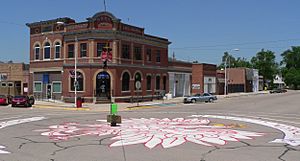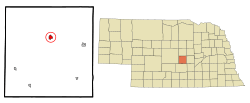Loup City, Nebraska facts for kids
Quick facts for kids
Loup City, Nebraska
|
|
|---|---|

Corner of 7th and O Streets in Loup City, May 2010. The painting on the pavement is the White Eagle from the Polish coat of arms.
|
|

Location of Loup City, Nebraska
|
|
| Country | United States |
| State | Nebraska |
| County | Sherman |
| Area | |
| • Total | 0.94 sq mi (2.44 km2) |
| • Land | 0.94 sq mi (2.44 km2) |
| • Water | 0.00 sq mi (0.00 km2) |
| Elevation | 2,070 ft (630 m) |
| Population
(2020)
|
|
| • Total | 1,053 |
| • Density | 1,118.0/sq mi (431.66/km2) |
| Time zone | UTC-6 (Central (CST)) |
| • Summer (DST) | UTC-5 (CDT) |
| ZIP code |
68853
|
| Area code(s) | 308 |
| FIPS code | 31-29470 |
| GNIS feature ID | 2395773 |
| Website | www.loupcity.com |
Loup City is a city in Sherman County, Nebraska, United States. It is also the county seat, which means it's the main town where the county government is located. In 2010, about 1,173 people lived there.
Loup City is found near the Middle Loup River. It is also about 5 miles (8 km) from Sherman Reservoir, a large lake.
Contents
History of Loup City
The first people settled in the Loup City area in the mid-1860s. The town was officially planned out in 1864. It was named after the nearby Loup River.
During the Great Depression in 1934, there was a disagreement in Loup City. Some people tried to organize workers at a poultry plant. This led to a clash with other local residents.
In 1963, the Sherman Reservoir was finished. This brought more visitors to the area, which helped the local economy.
People and Population in Loup City
| Historical population | |||
|---|---|---|---|
| Census | Pop. | %± | |
| 1890 | 871 | — | |
| 1900 | 926 | 6.3% | |
| 1910 | 1,128 | 21.8% | |
| 1920 | 1,364 | 20.9% | |
| 1930 | 1,446 | 6.0% | |
| 1940 | 1,675 | 15.8% | |
| 1950 | 1,508 | −10.0% | |
| 1960 | 1,415 | −6.2% | |
| 1970 | 1,456 | 2.9% | |
| 1980 | 1,368 | −6.0% | |
| 1990 | 1,104 | −19.3% | |
| 2000 | 1,116 | 1.1% | |
| 2010 | 1,173 | 5.1% | |
| 2020 | 1,053 | −10.2% | |
| U.S. Decennial Census | |||
Loup City Population in 2010
According to the census from 2010, Loup City had 1,173 people living in 702 households. The city had about 1,095 people per square mile (423 people per square kilometer).
Most of the people living in Loup City were White (98.7%). A small number were Native American (0.1%), Asian (0.4%), or from other backgrounds. About 1.6% of the population was Hispanic or Latino.
The average age of people in the city was 39.7 years old. About 22.2% of residents were under 18 years old. Also, 27.5% of residents were 65 years or older.
Geography of Loup City
The United States Census Bureau says that Loup City covers a total area of 0.94 square miles (2.44 square kilometers). All of this area is land.
Loup City Climate and Weather
| Climate data for Loup City, Nebraska (1991–2020 normals, extremes 1901–present) | |||||||||||||
|---|---|---|---|---|---|---|---|---|---|---|---|---|---|
| Month | Jan | Feb | Mar | Apr | May | Jun | Jul | Aug | Sep | Oct | Nov | Dec | Year |
| Record high °F (°C) | 75 (24) |
80 (27) |
92 (33) |
98 (37) |
101 (38) |
107 (42) |
112 (44) |
110 (43) |
105 (41) |
97 (36) |
85 (29) |
83 (28) |
112 (44) |
| Mean maximum °F (°C) | 60.1 (15.6) |
64.6 (18.1) |
77.4 (25.2) |
84.4 (29.1) |
89.7 (32.1) |
95.0 (35.0) |
98.4 (36.9) |
96.2 (35.7) |
92.3 (33.5) |
86.7 (30.4) |
74.5 (23.6) |
61.3 (16.3) |
99.1 (37.3) |
| Mean daily maximum °F (°C) | 37.4 (3.0) |
41.3 (5.2) |
52.6 (11.4) |
62.9 (17.2) |
72.9 (22.7) |
83.7 (28.7) |
88.2 (31.2) |
86.1 (30.1) |
78.7 (25.9) |
65.7 (18.7) |
51.7 (10.9) |
39.6 (4.2) |
63.4 (17.4) |
| Daily mean °F (°C) | 24.9 (−3.9) |
28.4 (−2.0) |
38.9 (3.8) |
49.0 (9.4) |
59.6 (15.3) |
70.8 (21.6) |
75.5 (24.2) |
73.3 (22.9) |
64.5 (18.1) |
51.2 (10.7) |
38.0 (3.3) |
27.6 (−2.4) |
50.1 (10.1) |
| Mean daily minimum °F (°C) | 12.4 (−10.9) |
15.5 (−9.2) |
25.1 (−3.8) |
35.1 (1.7) |
46.4 (8.0) |
57.9 (14.4) |
62.9 (17.2) |
60.5 (15.8) |
50.4 (10.2) |
36.7 (2.6) |
24.3 (−4.3) |
15.6 (−9.1) |
36.9 (2.7) |
| Mean minimum °F (°C) | −8.5 (−22.5) |
−5.1 (−20.6) |
6.6 (−14.1) |
21.3 (−5.9) |
32.2 (0.1) |
44.8 (7.1) |
52.0 (11.1) |
49.4 (9.7) |
35.0 (1.7) |
19.7 (−6.8) |
7.7 (−13.5) |
−2.9 (−19.4) |
−12.9 (−24.9) |
| Record low °F (°C) | −33 (−36) |
−32 (−36) |
−18 (−28) |
−4 (−20) |
20 (−7) |
33 (1) |
40 (4) |
36 (2) |
14 (−10) |
4 (−16) |
−16 (−27) |
−26 (−32) |
−33 (−36) |
| Average precipitation inches (mm) | 0.56 (14) |
0.66 (17) |
1.53 (39) |
2.94 (75) |
4.36 (111) |
4.14 (105) |
3.23 (82) |
3.19 (81) |
2.18 (55) |
1.88 (48) |
1.13 (29) |
0.67 (17) |
26.47 (672) |
| Average snowfall inches (cm) | 7.7 (20) |
6.5 (17) |
4.5 (11) |
1.2 (3.0) |
0.0 (0.0) |
0.0 (0.0) |
0.0 (0.0) |
0.0 (0.0) |
0.0 (0.0) |
1.3 (3.3) |
3.3 (8.4) |
6.2 (16) |
30.7 (78) |
| Average precipitation days (≥ 0.01 in) | 3.9 | 4.6 | 6.6 | 9.0 | 11.0 | 10.7 | 8.9 | 8.2 | 5.9 | 6.5 | 4.4 | 3.8 | 83.5 |
| Average snowy days (≥ 0.1 in) | 3.7 | 3.5 | 1.9 | 0.8 | 0.0 | 0.0 | 0.0 | 0.0 | 0.0 | 0.6 | 1.4 | 2.6 | 14.5 |
| Source: NOAA | |||||||||||||
Culture and Traditions in Loup City
Loup City is known as the "Polish capital of Nebraska." This is because many people with Polish heritage live there.
Every year, the town celebrates "Polish Days" on the first weekend of June. The local Catholic church, Saint Josaphat's, has beautiful stained glass windows. These windows remember local families, many of whom have Polish names. The windows are very old, from the early 1900s.
Loup City was also shown in the 2014 movie The Homesman.
Fun Things to Do in Loup City
Sherman Dam Recreation Area
The Sherman Dam area has a large lake (2,845 acres) and lots of land (4,721 acres). You can go camping at 360 spots. There are picnic tables, shelters, water, and restrooms. You can also find four boat ramps and places to clean fish.
Bowman Recreation Area
Bowman Lake is located one mile west of Loup City. It is a 23-acre area next to the Loup River. It has a 20-acre man-made lake. Here, you can enjoy picnics, fishing, and primitive camping.
Jenners Park for Outdoor Fun
Jenners Park used to have amusement rides and a zoo! Today, it's a great place for outdoor activities. It has a disc golf course, two picnic shelters, outdoor grills, and playground equipment.
Loup City Swimming Pool
The Loup City pool was built in 2000. It has a fun water slide, a diving board, a basketball hoop, and a mushroom water feature. It also has a "zero depth entry," which means you can walk right into the shallow end like a beach.
Loup City Golf Course
If you like golf, there's a 9-hole course one mile west of Loup City. It's a par 36 course with old trees, a creek, and several ponds.
Petersen Park Ball Fields
Petersen Park has two new baseball fields. They are used by teams from T-ball all the way up to high school softball. The park also has a playground for younger kids.
Famous People from Loup City
- Edmund C. Jaeger – A desert ecologist and naturalist who taught at Riverside City College for 30 years.
- Charles H. Mohr – A news reporter who covered wars in Vietnam and the Middle East.
- Richard Raymond – A well-known doctor from Nebraska. He also served in the Department of Agriculture during the George W. Bush Administration.
See also
 In Spanish: Loup City (Nebraska) para niños
In Spanish: Loup City (Nebraska) para niños

